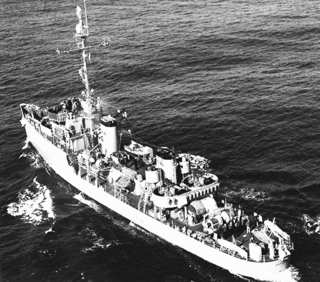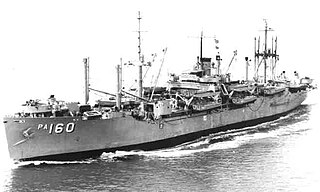
USS Cassin (DD-372) was a Mahan-class destroyer in the United States Navy before and during World War II. She was the second ship named for Stephen Cassin, an officer in the United States Navy.

USS Defense (AM-317) was an Auk-class minesweeper acquired by the United States Navy for the dangerous task of removing mines from minefields laid in the water to prevent ships from passing.
USS Milledgeville (PF-94), a Tacoma-class frigate, was the first ship of the United States Navy to be named for Milledgeville, Georgia.

The USS Culebra Island (ARG-7) was a Luzon-class internal combustion engine repair ship in the service of the United States Navy in World War II. Named after Culebra, an island between Puerto Rico and the Virgin Islands, it was the only ship of the Navy to bear this name.

USS Cebu (ARG-6) was a Luzon-class internal combustion engine repair ship that saw service in the United States Navy during World War II. Named after Cebu, an island in the Philippines, it was the second ship of the Navy to bear this name.

USS Zebra (AKN-5) was an Indus-class net cargo ship in the service of the United States Navy in World War II. The ship was originally the Matthew Lyon, an EC2-S-C1 Liberty ship, operated for the War Shipping Administration (WSA) as a cargo vessel by an agent until severely damaged by torpedo in August 1943. While at Espiritu Santo in the New Hebrides awaiting likely scrapping the Navy acquired the vessel under bareboat charter to be used as a net cargo ship transporting reclaimed anti-submarine netting.

USS Deuel (APA-160) was a Haskell-class attack transport in service with the United States Navy from 1944 to 1946 and from 1950 to 1956. She was scrapped in 1974.

USS Luzon (ARG-2) was an internal combustion engine repair ship that saw service in the United States Navy during World War II and the Korean War. She was the lead ship in a class of twelve and was named for the Island of Luzon, the chief island in the northern Philippines and site of the capital city of Manila. She is the second US Naval vessel to bear the name.

USS Atlas (ARL-7) was one of 39 Achelous-class landing craft repair ships built for the United States Navy during World War II. Named for Atlas, she was the second U.S. Naval vessel to bear the name.

USS Baham (AK-122/AG-71) was a Basilan-class auxiliary ship, converted from a Liberty ship, commissioned by the United States Navy for service in World War II. She was first named after former Florida, resident Elizabeth C. Bellamy, the daughter of General William Croom, and wife of Doctor Samuel C. Bellamy. According to legend she died on her wedding night when her dress caught fire, but she actually died three years after her wedding from malaria. She was renamed and commissioned after Baham, a star in constellation Pegasus. She was responsible for delivering troops, goods and equipment to locations in the war zone.

USS Quapaw (ATF–110/AT-110) was a Abnaki-class fleet ocean tug in the United States Navy. She was named after the Quapaw.

USS Etamin (AK-93) was the Liberty ship (EC2) Isaac Babbitt constructed for the US Maritime Commission (MARCOM) in 1943, for World War II service at a cost of $959,509. After acquisition by the US Navy, the ship was named Etamin, after the brightest star in the constellation Draco and manned by a US Coast Guard crew. As a Crater-class cargo ship, she served the military in the Pacific Ocean by providing food and material until she was torpedoed and put out of service. After repairs, she served as a non-self-propelled floating warehouse for the rest of the war. The ship ended the war in the Philippines and was among fifteen hulls sold for scrap for a lump sum of $271,000.

USS Dionysus (AR-21) was a Xanthus-class repair ship in the service of the United States Navy from 1945 to 1955.

USS Fieberling (DE-640) was a Buckley-class destroyer escort in service with the United States Navy from 1944 to 1948. She sold for scrap in 1972.

USS Basilan (AG-68/ARG-12) was a Basilan-class miscellaneous auxiliary acquired by the U.S. Navy during World War II. The ship was designed as a combined barracks-stores-water distillation ship, but was later converted to an electronics repair ship. She spent her Navy career in the Pacific Ocean theatre of operations.

SS Dalton Victory was built as Victory ship used as a cargo ship for World War II under the Emergency Shipbuilding program. She was launched by the California Shipbuilding Company on 6 June 1944 and completed on 19 July 1944 as a Greenville Victory-class cargo ship. The ship’s United States Maritime Commission designation was VC2- S- AP3, hull number 21. She was acquired by the U.S. Navy in 1950 and renamed the USNS Dalton Victory (T-AK-256).

USS Skywatcher (YAGR/AGR-3) was a Guardian-class radar picket ship, converted from a Liberty Ship, acquired by the US Navy in 1954. She was converted into a radar picket ship and assigned to radar picket duty in the North Atlantic Ocean as part of the Distant Early Warning Line.

USS Searcher (YAGR/AGR-4) was a Guardian-class radar picket ship, converted from a Liberty Ship, acquired by the US Navy in 1954. She was obtained from the National Defense Reserve Fleet and reconfigured as a radar picket ship and assigned to radar picket duty in the North Atlantic Ocean as part of the Distant Early Warning Line.

USS Vigil (AGR/YAGR-12) was a Guardian-class radar picket ship, converted from a Liberty Ship, acquired by the US Navy in 1956. She was reconfigured as a radar picket ship and assigned to radar picket duty in the North Atlantic Ocean as part of the Distant Early Warning Line.

Granville S. Hall was a Liberty ship named after Granville S. Hall. She was built at the J.A. Jones Construction, Panama City, Florida, and launched in 1944, to serve as a civilian cargo ship. In 1953 she was acquired by the United States Navy for use as a miscellaneous auxiliary service craft under the designation YAG-40. As YAG-40 she took part in Operation Castle before being laid up again in 1957. Reactivated in 1962, she was commissioned as Granville S. Hall (YAG-40) and participated in Project SHAD and Project 112. She was scrapped in 1972.


















